ChatGPT ranks top 10 quarterbacks in Notre Dame history

No position in sports is more important than the quarterback. Notre Dame is lucky that it will have a good one this season in Sam Hartman. Though his services only will be for one year, the potential for him to have a history-making season is high. With that will come high expectations.
But how will Hartman measure up to the great Notre Dame quarterbacks of the past? For that, let’s turn to AI writing tool ChatGPT and see what it believes is a fair list for the top 10 men under center to play for the Irish.
Keep in mind that ChatGPT has this disclaimer:
“Ranking the top 10 quarterbacks in Notre Dame history is subjective and open to interpretation, as different eras and playing styles contribute to individual greatness. However, based on their impact on the program, statistical achievements, and team success, the following list represents 10 notable quarterbacks in Notre Dame’s storied history.”
And this one:
“Please note that this list is not exhaustive, and there are many other talented quarterbacks who have contributed to the Notre Dame football legacy. The rankings can vary depending on personal opinions and criteria used to evaluate their performances.”
On that, here is the list with some entries edited for clarity and accuracy:
Joe Montana

“Joe Montana’s collegiate career at the University of Notre Dame marked the beginning of his football journey and showcased the skills that would propel him to become one of the greatest quarterbacks in the history of the sport. Montana played for the Fighting Irish from 1975 to 1978 under the guidance of head coach Dan Devine.
During his time at Notre Dame, Montana exhibited exceptional poise, leadership, and an ability to deliver clutch performances. He became known for his ability to orchestrate come-from-behind victories and his knack for thriving under pressure.
Montana helped lead Notre Dame to a memorable comeback win in the 1979 Cotton Bowl against the University of Houston. Trailing, 34-12, in the fourth quarter, he orchestrated a remarkable comeback, throwing two touchdown passes to secure a thrilling 35-34 victory. This game, often referred to as the ‘Chicken Soup Game,’ is considered one of the most memorable moments in college football history and helped solidify Montana’s reputation as a clutch player.
Montana’s senior season at Notre Dame in 1978 further highlighted his skills and leadership. He led the Fighting Irish to a 9-3 record, including the Cotton Bowl victory. Montana’s performance during his senior year earned him numerous accolades, including being named an All-American and finishing third in Heisman Trophy voting.
His successful tenure at Notre Dame set the foundation for his future success in the NFL. Montana’s time with the Fighting Irish showcased his ability to perform under pressure, make precise throws, and lead his team to victory. His impressive collegiate career laid the groundwork for the legendary status he would attain during his professional career with the San Francisco 49ers and the Kansas City Chiefs.”
Johnny Lujack
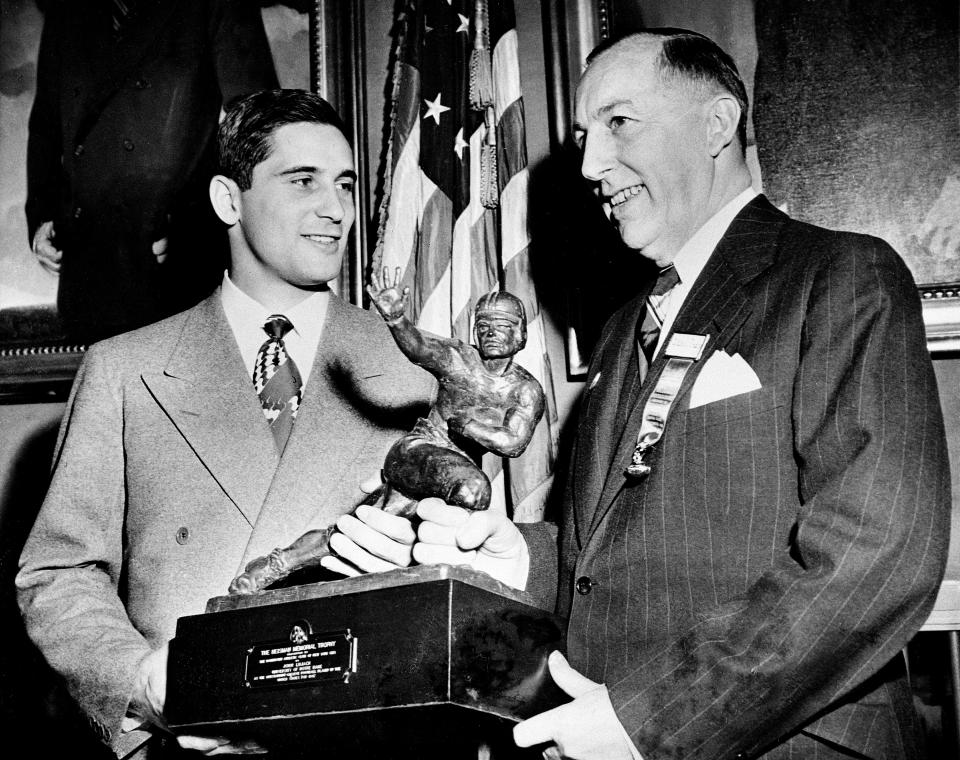
“Johnny Lujack is a former American football player who achieved great success as a quarterback for the University of Notre Dame in the late 1940s. He was born on January 4, 1925, in Connellsville, Pennsylvania.
Lujack’s collegiate career at Notre Dame spanned from 1943 to 1947, with an interruption due to his military service during World War II. He returned to the university after the war and made an indelible mark on the football program.
During his time at Notre Dame, Lujack demonstrated exceptional talent, leadership, and versatility. He played a crucial role in helping the Fighting Irish win three national championships in 1943, 1946, and 1947. Lujack’s success on the field earned him the prestigious Heisman Trophy in 1947, recognizing him as the best player in college football that year.
Lujack was known for his strong arm, precise passing, and intelligent decision-making. He was equally adept at running the ball, showcasing his versatility as a dual-threat quarterback. Lujack’s leadership and ability to make clutch plays were instrumental in Notre Dame’s dominant performances during his tenure.
After his collegiate career, Lujack was drafted by the Chicago Bears in the first round of the 1948 NFL Draft. He played for the Bears from 1948 to 1951, earning several accolades, including being named an All-Pro in 1949 and 1950. Lujack’s professional career was cut short due to injuries, but his impact on the game and his legacy as one of Notre Dame’s greatest quarterbacks remain intact.
Johnny Lujack’s contributions to Notre Dame football, including his leadership, skill, and achievements, have firmly established him as one of the program’s legendary figures. His Heisman Trophy, national championships, and impressive performances continue to be remembered and celebrated by Fighting Irish fans and the football community at large.”
Joe Theismann
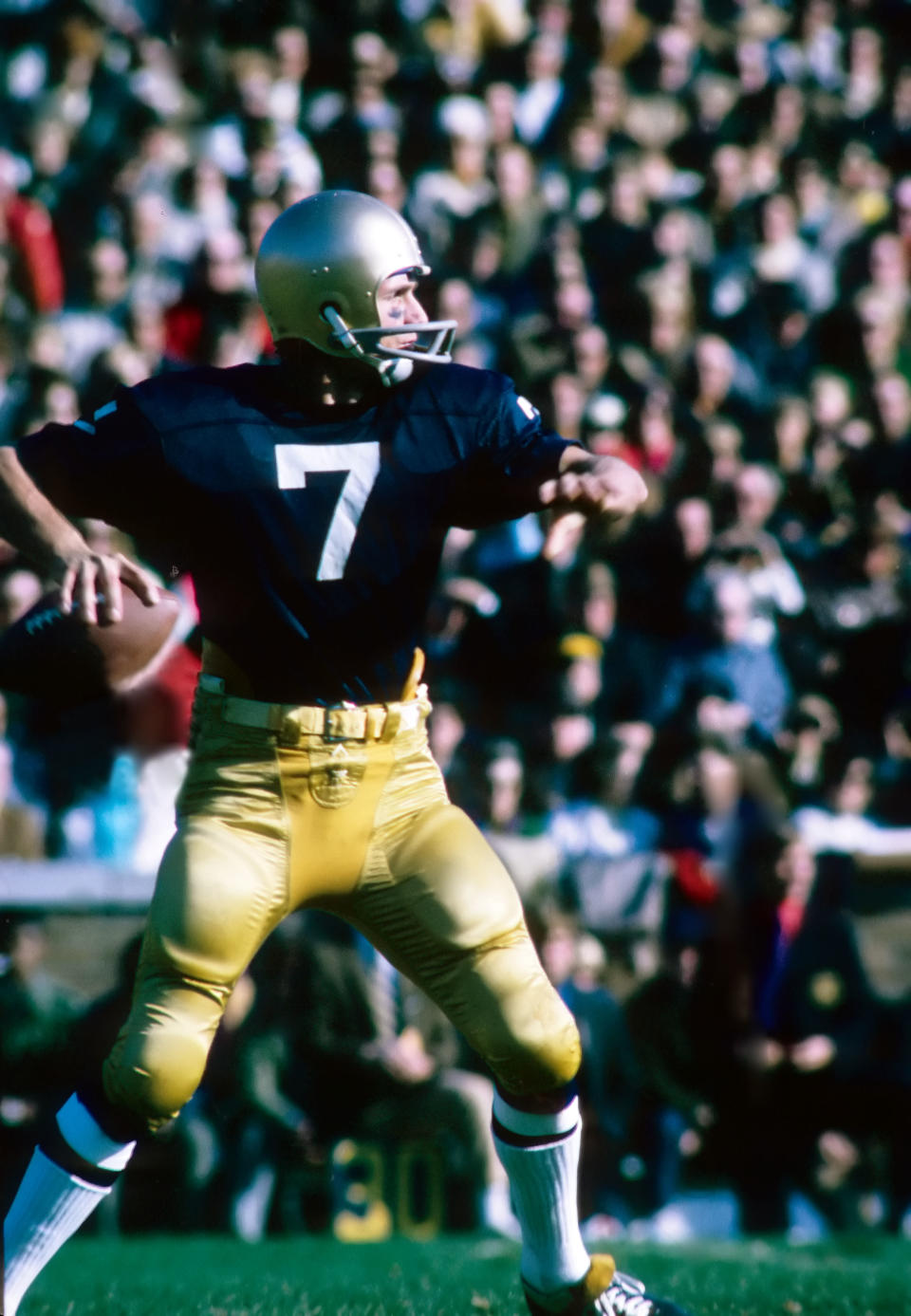
“Joe Theismann’s career at the University of Notre Dame was marked by his impressive quarterback play, leadership, and his contribution to the success of the Fighting Irish football program. He played for Notre Dame from 1968 to 1970, leaving a lasting impact on the school’s football legacy.
As a quarterback, Theismann showcased his strong arm, accuracy, and ability to lead the offense with poise. In his junior season in 1969, he helped lead the Fighting Irish to an impressive 8-2 record and a victory in the Cotton Bowl against the University of Texas. Theismann’s performance earned him recognition as an All-American and established him as one of the nation’s top college quarterbacks.
The following year, in his senior season in 1970, Theismann’s exceptional play continued. He led Notre Dame to a 10-1 record, capturing the hearts of fans with his skills and leadership on the field. Theismann’s notable accomplishments that season included leading the team to a thrilling comeback victory over the University of Alabama in the Sugar Bowl, earning him the game’s MVP award.
During his time at Notre Dame, Theismann’s success and impact extended beyond the field. He demonstrated strong leadership qualities and was highly regarded by his teammates and coaches for his work ethic and dedication. Theismann’s exceptional performances and his ability to rally the team were integral to Notre Dame’s success during his tenure.
Following his successful collegiate career, Theismann went on to have a successful professional career in the National Football League (NFL). He played for the Washington Commanders (formerly the Washington Redskins) from 1974 to 1985, earning numerous accolades, including being named the NFL Most Valuable Player (MVP) in 1983.
Joe Theismann’s legacy at Notre Dame is characterized by his impressive performances as a quarterback, his leadership abilities, and his significant contributions to the program’s success. His accomplishments at the university paved the way for his successful professional career and solidified his place as one of the notable quarterbacks in Notre Dame’s rich football history.”
Brady Quinn
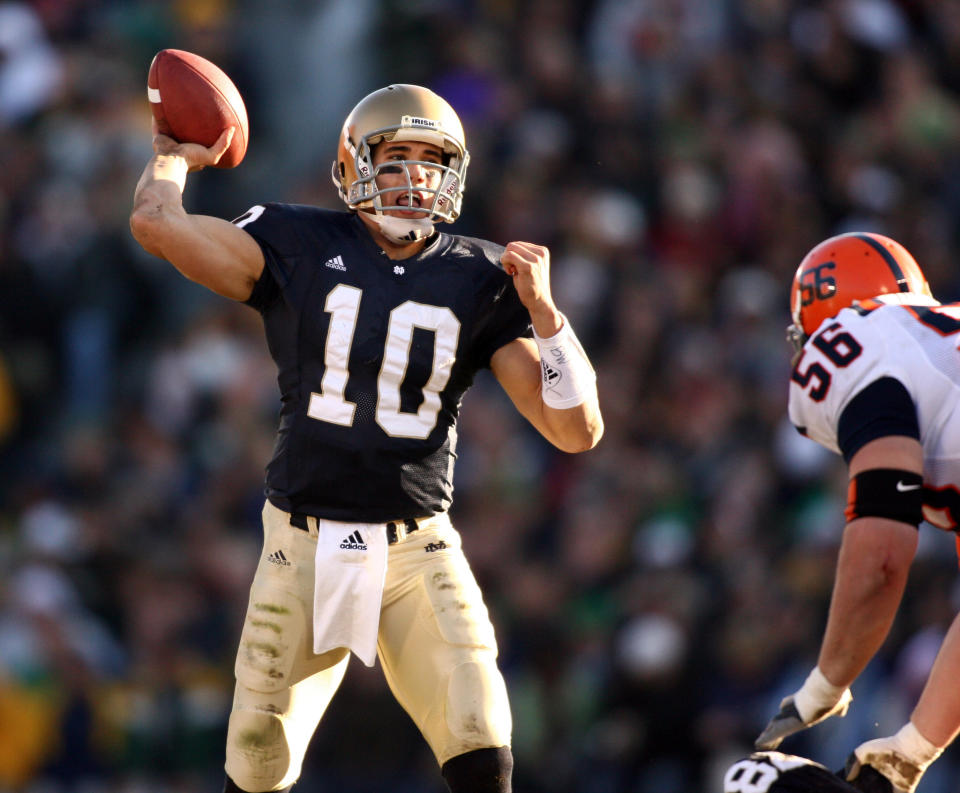
“Brady Quinn is a former American football player who gained recognition as a quarterback at both the collegiate and professional levels. He was born on October 27, 1984, in Columbus, Ohio.
Quinn had an outstanding collegiate career at the University of Notre Dame, where he played from 2003 to 2006. As a Fighting Irish quarterback, he set numerous school records and garnered attention as one of the nation’s top players at his position. Quinn’s strong arm, intelligence, and leadership skills made him a formidable force on the field.
During his time at Notre Dame, Quinn earned numerous accolades, including being named a finalist for the Heisman Trophy in 2006. He also received the Johnny Unitas Golden Arm Award, which recognizes the top senior quarterback in college football. Quinn’s success led Notre Dame to multiple bowl game appearances, solidifying his reputation as one of the program’s most successful quarterbacks.
Following his collegiate career, Quinn was selected in the first round of the 2007 NFL Draft by the Cleveland Browns. He played in the NFL for several teams, including the Browns, Denver Broncos, Kansas City Chiefs, New York Jets, and St. Louis Rams. While his professional career did not reach the same heights as his college years, he displayed resilience and commitment as he navigated the competitive landscape of the NFL.
Beyond his playing career, Quinn has also contributed to football as a broadcaster and commentator, providing analysis and insights into the game.
Brady Quinn’s skillset, achievements at Notre Dame, and subsequent NFL career have solidified his place among notable quarterbacks. His tenure with the Fighting Irish remains a memorable chapter in the program’s history, highlighting his impact on the field and his contributions to the game of football as a whole.”
Terry Hanratty
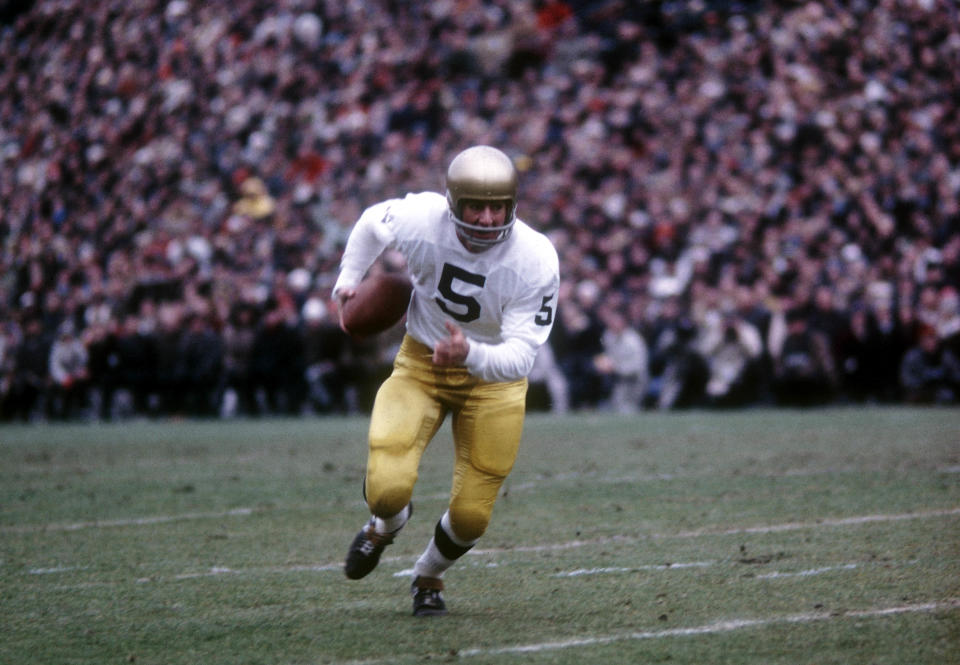
“Terry Hanratty is a former American football player who gained recognition as a quarterback during his collegiate and professional career. He was born on January 19, 1948, in Butler, Pennsylvania.
Hanratty attended the University of Notre Dame, where he played football from 1966 to 1968. As the starting quarterback for the Fighting Irish, Hanratty showcased his talent, leadership, and poise on the field. He was known for his strong arm and ability to make accurate throws, earning him the respect of his teammates and opponents alike.
During his time at Notre Dame, Hanratty helped lead the team to great success. He played a significant role in Notre Dame’s national championship victory in 1966. Hanratty’s performances on the field earned him recognition and accolades, including being named an All-American in 1966.
After his successful collegiate career, Hanratty was drafted by the Pittsburgh Steelers in the second round of the 1969 NFL Draft. He played for the Steelers from 1969 to 1975 as a backup quarterback, primarily behind Terry Bradshaw. Although Hanratty did not have an extensive career as a starting quarterback in the NFL, his contributions to the team were recognized and appreciated by his teammates and coaches.
Following his playing career, Hanratty has remained involved in football as a broadcaster and commentator, providing insights and analysis to fans.
Terry Hanratty’s skill, leadership, and contributions to the success of the University of Notre Dame’s football program remain an important part of the school’s history. His performances at the collegiate level and his time with the Pittsburgh Steelers have cemented his place in the annals of football, leaving a lasting impact on the sport and the teams he represented.”
Paul Hornung
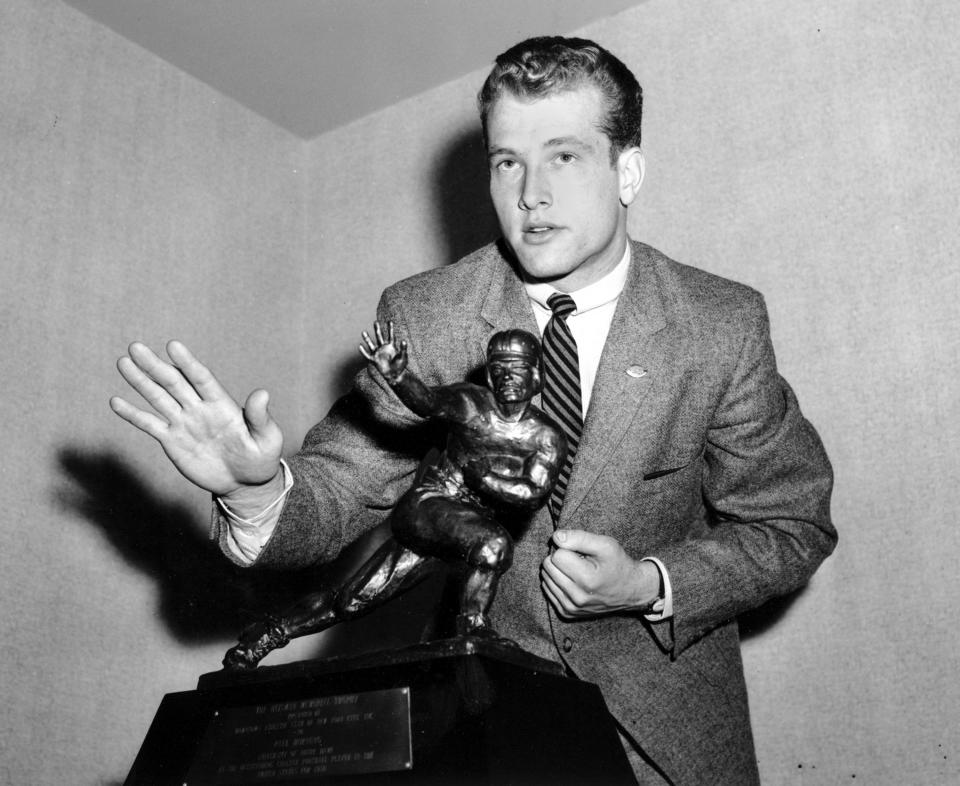
“Paul Hornung’s collegiate career at the University of Notre Dame was marked by his exceptional football skills, versatility, and his contributions to the success of the Fighting Irish program. Hornung played for Notre Dame from 1954 to 1956, leaving an indelible mark on the university’s football legacy.
As a student-athlete at Notre Dame, Hornung showcased his remarkable versatility by excelling in multiple positions. He primarily played as a halfback but also contributed as a quarterback, placekicker, and punter. This ability to impact the game in various ways made him a true asset to the Fighting Irish.
Hornung’s junior season in 1955 was particularly notable, as he led Notre Dame to a successful 8-2 record. His performances on the field were instrumental in securing victories and establishing his reputation as a dynamic player. Hornung’s versatility was on full display as he demonstrated his running and passing abilities, while also making significant contributions as a kicker.
The following year, in 1956, Hornung further solidified his status as a standout player. Despite Notre Dame’s overall team record being less successful, Hornung’s individual performances earned him the prestigious Heisman Trophy. This recognition made him the first player from a losing team to win the Heisman, a testament to his exceptional talent and impact on the game.
Hornung’s tenure at Notre Dame showcased his ability to excel in multiple facets of the game, making him a vital asset to the team’s success. His remarkable versatility as a player, coupled with his leadership qualities, made him a beloved figure among Fighting Irish fans.
Beyond his accomplishments on the field, Hornung’s legacy at Notre Dame extends to his status as an iconic figure in the university’s football history. His exceptional performances and his contributions to the team’s success during his time at Notre Dame solidified his place among the program’s greats.
Paul Hornung’s collegiate career at Notre Dame set the foundation for his future accomplishments in professional football and cemented his reputation as a versatile and dynamic player. His impact on the game, both at the university and beyond, is an enduring part of his football legacy.”
Ron Powlus
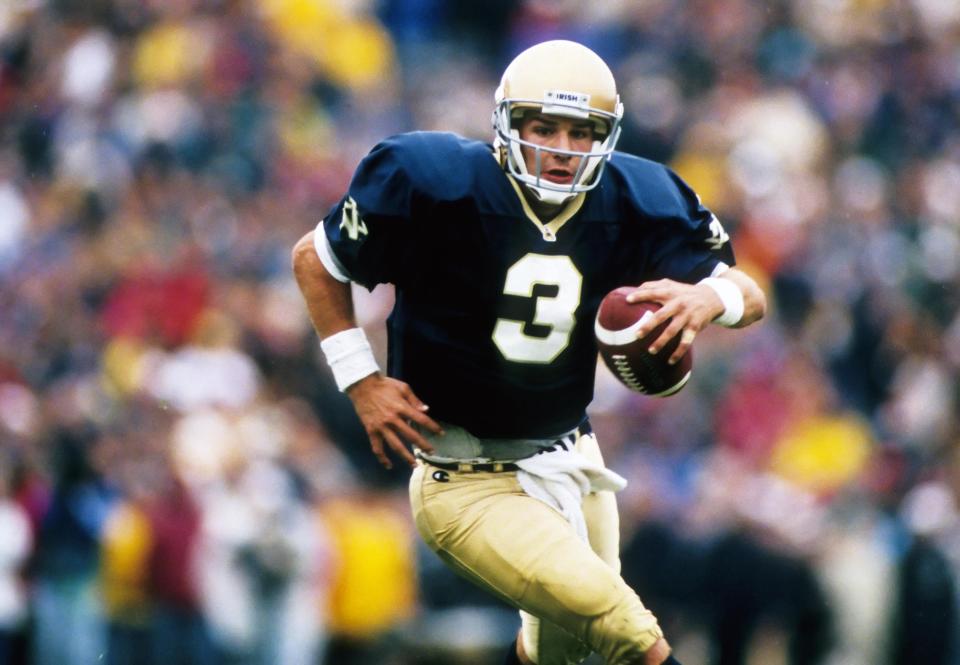
“Ron Powlus is a former American football player who gained recognition as a quarterback during his collegiate career at the University of Notre Dame. He was born on July 16, 1974, in Berwick, Pennsylvania.
Powlus played for the Fighting Irish from 1994 to 1997 and became one of the most highly anticipated recruits in Notre Dame history. He was a highly touted high school quarterback and arrived at Notre Dame with immense expectations.
During his time at Notre Dame, Powlus demonstrated his skills as a pocket passer and his leadership abilities on the field. He started as the team’s quarterback for four seasons, becoming one of the rare players to earn a starting role as a freshman. Powlus’ tenure was marked by his toughness, intelligence, and commitment to the team.
While Powlus faced challenges and injuries throughout his career, he still managed to achieve notable accomplishments. He set several school passing records, including career completions, passing yards, and touchdown passes. Powlus’ statistical achievements showcased his talent and impact on the Fighting Irish offense.
Off the field, Powlus was highly respected for his leadership qualities and his ability to rally his teammates. His work ethic and dedication made him a respected figure within the Notre Dame football program.
Following his collegiate career, Powlus had an opportunity to play in the NFL. He was selected by the Kansas City Chiefs in the fourth round of the 1998 NFL Draft but did not find significant success at the professional level.
After his playing career, Powlus transitioned to coaching and served in various coaching roles, including as an assistant coach at Notre Dame. He continued to contribute to the sport by sharing his knowledge and experiences with younger players.
Ron Powlus’ time at Notre Dame, while not without challenges, solidified his place in the program’s history. His contributions as a quarterback, his records, and his leadership qualities made him a respected figure among Fighting Irish fans and a significant part of Notre Dame’s football legacy.”
Rick Mirer
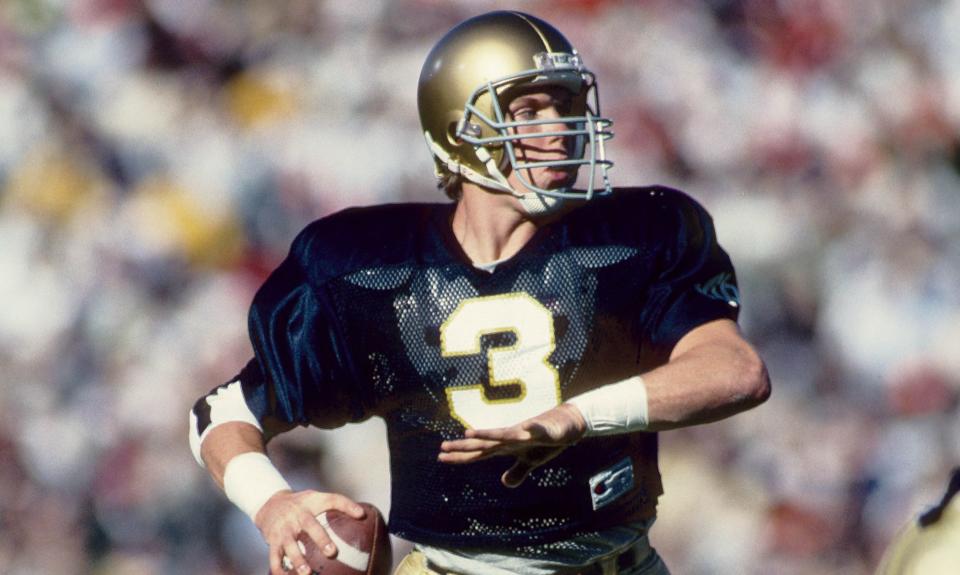
“Rick Mirer is a former American football player who gained recognition as a quarterback during his collegiate and professional career. He was born on March 19, 1970, in Goshen, Indiana.
Mirer played college football at the University of Notre Dame from 1989 to 1992. During his time at Notre Dame, he emerged as one of the top quarterbacks in the nation and garnered considerable attention for his skill set and potential.
Mirer’s collegiate career was marked by his strong arm, athleticism, and ability to make plays with both his arm and legs. He led the Fighting Irish to multiple bowl game appearances, including the Sugar Bowl and the Fiesta Bowl. His performances on the field earned him recognition and accolades, such as being named the MVP of the 1992 Sugar Bowl.
Following his successful tenure at Notre Dame, Mirer entered the 1993 NFL Draft and was selected as the second overall pick by the Seattle Seahawks. He entered the NFL with high expectations, but his professional career did not reach the same level of success as his college days.
Mirer played in the NFL for several teams, including the Seattle Seahawks, Chicago Bears, New York Jets, San Francisco 49ers, Oakland Raiders, and Detroit Lions. He faced challenges in finding consistent success at the professional level, and his career was characterized by ups and downs.
After his playing career, Mirer pursued business ventures outside of football, including the establishment of a winery in Oregon.
While Rick Mirer’s professional career may not have lived up to the high expectations set during his college days, his time at Notre Dame solidified his status as one of the program’s notable quarterbacks. His contributions to the Fighting Irish and his memorable performances on the field remain a part of his football legacy.”
Jimmy Clausen
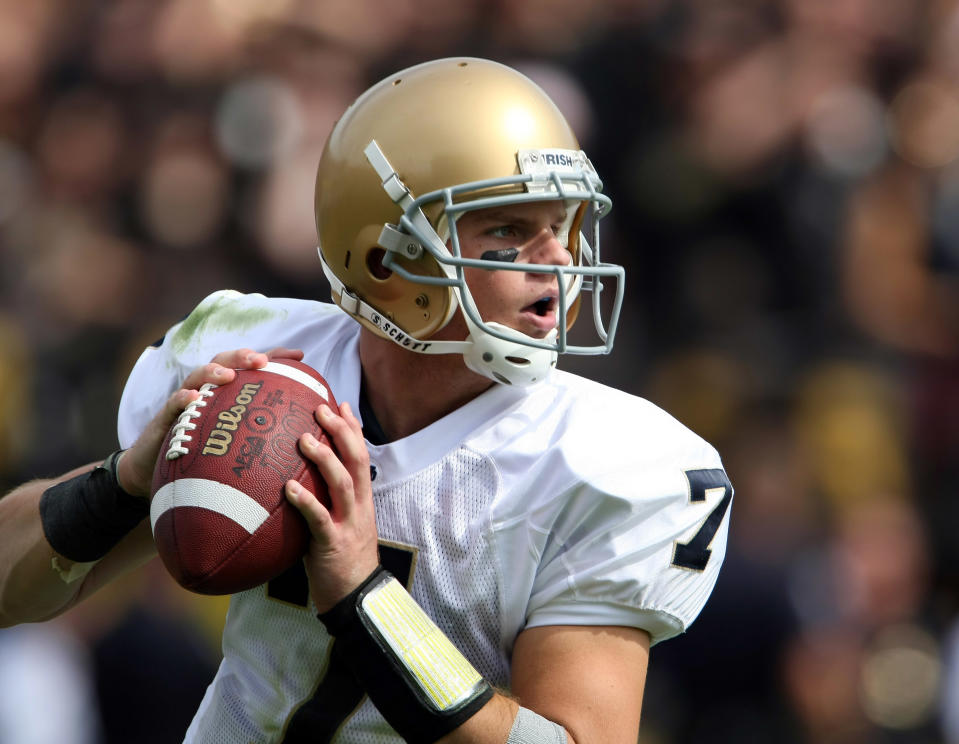
“Jimmy Clausen is a former American football player who gained recognition as a quarterback during his collegiate and professional career. He was born on September 21, 1987, in Thousand Oaks, California.
Clausen played college football at the University of Notre Dame from 2007 to 2009. He arrived at Notre Dame as one of the most highly touted high school quarterback recruits in the nation. Clausen’s time at Notre Dame was marked by his strong arm, accuracy, and poise in the pocket.
During his sophomore season in 2008, Clausen showed significant improvement and led Notre Dame to a 7-6 record. He displayed his ability to make precise throws and demonstrated leadership on the field. Clausen’s performances helped revive the Fighting Irish program under head coach Charlie Weis.
In his junior season in 2009, Clausen reached new heights as a quarterback. He threw for 3,722 yards and 28 touchdowns, leading Notre Dame to a 6-6 record. Clausen’s impressive statistics and improved play garnered attention, and he finished third in Heisman Trophy voting that year.
After his junior season, Clausen decided to forego his senior year at Notre Dame and entered the 2010 NFL draft. He was selected in the second round by the Carolina Panthers. Clausen’s professional career did not reach the same level of success as his college days, and he faced challenges in finding consistent success at the NFL level.
Clausen played in the NFL for several teams, including the Carolina Panthers, Chicago Bears, Baltimore Ravens, and Washington Commanders. After his time in the NFL, he transitioned to coaching and became a high school football coach.
Jimmy Clausen’s collegiate career at Notre Dame showcased his potential and talent as a quarterback. His contributions to the Fighting Irish and his notable performances on the field remain a part of his football legacy.”
Tommy Rees
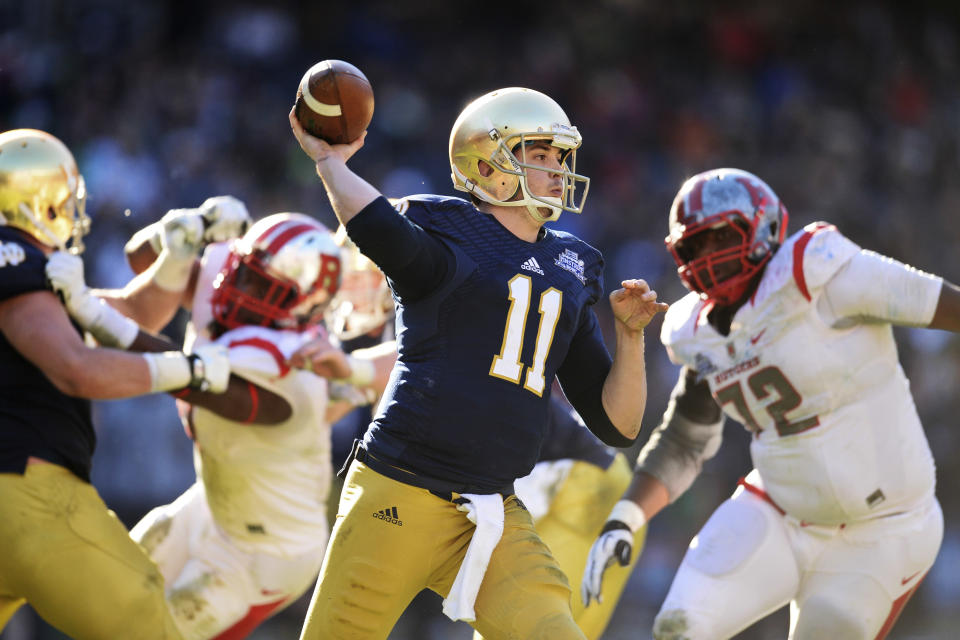
“Tommy Rees is a former American football player and current coach who gained recognition as a quarterback during his time at the University of Notre Dame. He was born on May 22, 1992, in Los Angeles.
Rees played college football at Notre Dame from 2010 to 2013. He started his career as a backup quarterback but quickly earned playing time due to his strong arm, football IQ, and ability to lead the offense effectively.
In his freshman year in 2010, Rees was thrust into action due to injuries to the starting quarterback. He displayed composure and poise beyond his years, leading Notre Dame to several victories and earning a reputation as a reliable game manager. Rees played a crucial role in the team’s run to the 2010 Sun Bowl, where he was named the game’s MVP.
Throughout his collegiate career, Rees split playing time with other quarterbacks, alternating between starting and coming off the bench. His ability to step in when needed and perform at a high level showcased his preparation and readiness as a quarterback.
After his playing career at Notre Dame, Rees transitioned to coaching. He served as a graduate assistant at Northwestern University before returning to Notre Dame as a quarterback coach in 2017. In 2021, Rees was promoted to offensive coordinator, a role in which he led and developed the Fighting Irish offense until he took the same position with Alabama for the 2023 season.
Tommy Rees’ career at Notre Dame exemplified his dedication, football knowledge, and ability to step up in critical situations. His transition to coaching has allowed him to continue contributing to the sport and to the development of future players.”

